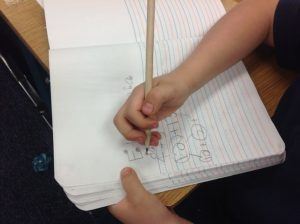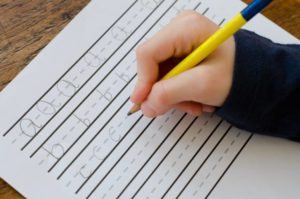writing
After reading Prewriting Tips to Grow On and working on these skills with your child, you should be on the right track to begin handwriting letters and numbers with your child.
1. By 5, your child should begin writing numbers 1-5 and capital letters of his/her first name.
At first, give your child opportunities to trace the capital letters of his/her first name. Once they have mastered this and stay on the lines, they are able to begin writing the letters with a visual model. Focus on learning the appropriate formation of each letter, beginning all letters at the top rather than the bottom. Learning how to form letters correctly from the beginning helps them succeed later. Once your child’s formation of letters is appropriate, work on writing letters independently, without a visual model. When your child learns to write his/her name, s/he is ready to learn the rest of the alphabet.
2. By 5.5, your child should be able to write numbers 1-10 and all capital letters.
Start with capital letters A-M. Begin tracing, then writing with a visual model, and move onto writing independently. Then focus on N-Z following the same sequence. Lastly, put it all together, writing letters A-Z independently.
3. By around 6.5, your child should be able to write all lower case letters.
Follow the same sequence with lower case letters as you did with upper case letters. Lower case letters can also be divided into 3 different categories (tall, diver, and other letters) to teach.
Tall letters: b, d, f, h, k, l, t
Diver letters: g, j, p, q, y
If your child is having difficulty with letter formation, try making starting dots so your child knows where to begin each letter. Also writing in different mediums such as finger paint, sand, shaving cream, playdoh, chalk, and dry erase markers can help children learn how to form letters. Writing in different tactile mediums has been proven to help children learn to write.
After your child has mastered forming capital and lower case letters, it is now time to work on line alignment and sizing. Using horizontal three lined paper (ADD picture) with bold/colored top and bottom lines can assist with line alignment and sizing. Additionally, highlighting these boarders can help. Highlighting the space below the dotted line can help with alignment of lower case letters.
It is now time to move onto writing words and sentences. Make sure letters stay formed and aligned correctly when completing these tasks; sometimes when children begin to write words their formation and alignment decrease. You will now also have to focus on spacing letters within words and spacing between words. The best way to space between words is to use your child’s finger as a space marker.
Again, if you are having concerns or if you child is not progressing like you think s/he should, please do not hesitate to contact ABC Pediatric Therapy and specifically ask for an occupational therapist for more ideas geared towards your specific needs and if you have any additional questions or would like a free screening. Visit our website at www.abcpediatrictherapy.com to find the location nearest you.
Read More Skip to content
Skip to content
